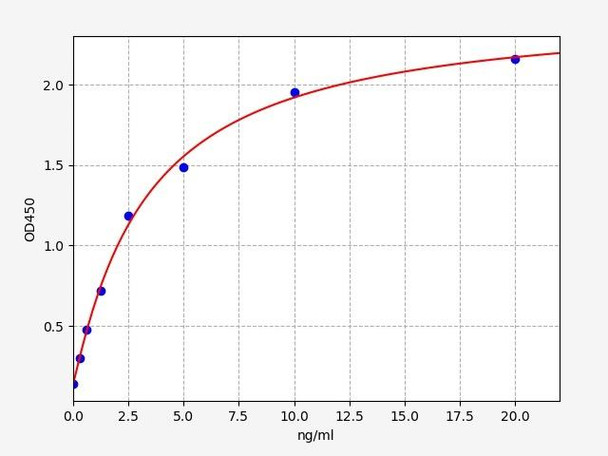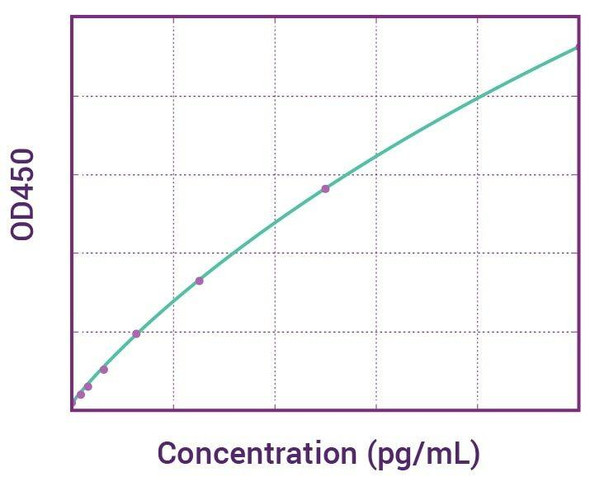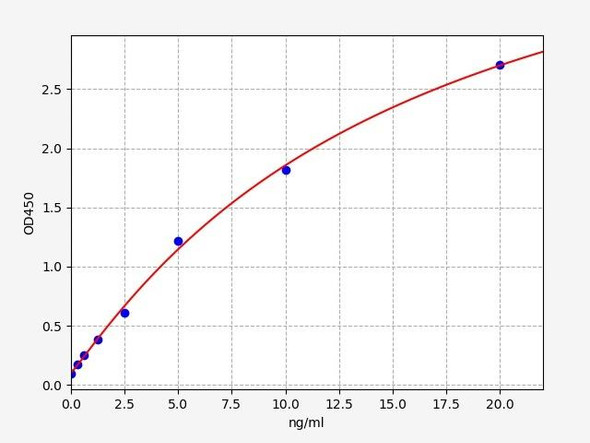Human gp340 ELISA Kit (HUFI01458)
- SKU:
- HUFI01458
- Product Type:
- ELISA Kit
- Size:
- 96 Assays
- Uniprot:
- Q9UGM3
- Sensitivity:
- 0.188ng/ml
- Range:
- 0.313-20ng/ml
- ELISA Type:
- Sandwich
- Synonyms:
- DMBT1, Deleted in malignant brain tumors 1 protein, Surfactant pulmonary-associated D-binding protein, Salivary agglutinin, SAG, Glycoprotein 340, Gp-340, Hensin, GP340, muclin
- Reactivity:
- Human
- Research Area:
- Immunology
Description
Human gp340 ELISA Kit
The Human GP340 ELISA Kit is a powerful tool for the precise measurement of GP340 levels in human samples such as serum, plasma, and cell culture supernatants. With its exceptional sensitivity and specificity, this kit delivers consistent and accurate results, making it an indispensable asset for a variety of research endeavors.GP340 is a key protein that plays a crucial role in the immune system, functioning as a pattern recognition receptor and contributing to host defense against various pathogens.
Its dysregulation has been linked to inflammatory diseases, respiratory disorders, and infections, making it a valuable biomarker for investigating these conditions and exploring potential therapeutic interventions.Overall, the Human GP340 ELISA Kit offers a reliable and efficient means of studying GP340 levels and its implications in health and disease, providing researchers with valuable insights and opportunities for advancing their scientific inquiries.
| Product Name: | Human gp340 ELISA Kit |
| Product Code: | HUFI01458 |
| Size: | 96 Assays |
| Alias: | DMBT1, Deleted in malignant brain tumors 1 protein, Surfactant pulmonary-associated D-binding protein, Salivary agglutinin, SAG, Glycoprotein 340, Gp-340, Hensin, GP340, muclin |
| Detection method: | Sandwich ELISA, Double Antibody |
| Application: | This immunoassay kit allows for the in vitro quantitative determination of Human DMBT1 concentrations in serum plasma and other biological fluids. |
| Sensitivity: | 0.188ng/ml |
| Range: | 0.313-20ng/ml |
| Storage: | 4°C for 6 months |
| Note: | For Research Use Only |
| Recovery: | Matrices listed below were spiked with certain level of Human DMBT1 and the recovery rates were calculated by comparing the measured value to the expected amount of Human DMBT1 in samples. | ||||||||||||||||
| |||||||||||||||||
| Linearity: | The linearity of the kit was assayed by testing samples spiked with appropriate concentration of Human DMBT1 and their serial dilutions. The results were demonstrated by the percentage of calculated concentration to the expected. | ||||||||||||||||
| |||||||||||||||||
| CV(%): | Intra-Assay: CV<8% Inter-Assay: CV<10% |
| Component | Quantity | Storage |
| ELISA Microplate (Dismountable) | 8×12 strips | 4°C for 6 months |
| Lyophilized Standard | 2 | 4°C/-20°C |
| Sample/Standard Dilution Buffer | 20ml | 4°C |
| Biotin-labeled Antibody(Concentrated) | 120ul | 4°C (Protect from light) |
| Antibody Dilution Buffer | 10ml | 4°C |
| HRP-Streptavidin Conjugate(SABC) | 120ul | 4°C (Protect from light) |
| SABC Dilution Buffer | 10ml | 4°C |
| TMB Substrate | 10ml | 4°C (Protect from light) |
| Stop Solution | 10ml | 4°C |
| Wash Buffer(25X) | 30ml | 4°C |
| Plate Sealer | 5 | - |
Other materials and equipment required:
- Microplate reader with 450 nm wavelength filter
- Multichannel Pipette, Pipette, microcentrifuge tubes and disposable pipette tips
- Incubator
- Deionized or distilled water
- Absorbent paper
- Buffer resevoir
| Uniprot | Q9UGM3 |
| UniProt Protein Function: | DMBT1: May be considered as a candidate tumor suppressor gene for brain, lung, esophageal, gastric, and colorectal cancers. May play roles in mucosal defense system, cellular immune defense and epithelial differentiation. May play a role as an opsonin receptor for SFTPD and SPAR in macrophage tissues throughout the body, including epithelial cells lining the gastrointestinal tract. May play a role in liver regeneration. May be an important factor in fate decision and differentiation of transit-amplifying ductular (oval) cells within the hepatic lineage. Required for terminal differentiation of columnar epithelial cells during early embryogenesis. May function as a binding protein in saliva for the regulation of taste sensation. Binds to HIV-1 envelope protein and has been shown to both inhibit and facilitate viral transmission. Displays a broad calcium-dependent binding spectrum against both Gram-positive and Gram-negative bacteria, suggesting a role in defense against bacterial pathogens. Binds to a range of poly- sulfated and poly-phosphorylated ligands which may explain its broad bacterial-binding specificity. Inhibits cytoinvasion of S.enterica. Associates with the actin cytoskeleton and is involved in its remodeling during regulated exocytosis. Interacts with pancreatic zymogens in a pH-dependent manner and may act as a Golgi cargo receptor in the regulated secretory pathway of the pancreatic acinar cell. Defects in DMBT1 are involved in the development of glioma (GLM). Gliomas are central nervous system neoplasms derived from glial cells and comprise astrocytomas, glioblastoma multiforme, oligodendrogliomas, and ependymomas. Homozygous deletions may be the predominant mechanism of DMBT1 inactivation playing a role in carcinogenesis. DMBT1 is deleted in medulloblastoma and glioblastoma cell lines; point mutations have also been reported in patients with glioma. A loss or reduction of DMBT1 expression has been seen in esophageal, gastric, lung and colorectal carcinomas as well. Belongs to the DMBT1 family. 8 isoforms of the human protein are produced by alternative splicing. |
| UniProt Protein Details: | Protein type:Secreted; Oncoprotein; Membrane protein, integral; Tumor suppressor; Secreted, signal peptide Chromosomal Location of Human Ortholog: 10q26.13 Cellular Component: cytoplasm; extracellular region; extracellular space; extrinsic to membrane; phagocytic vesicle membrane; zymogen granule membrane Molecular Function:calcium-dependent protein binding; pattern recognition receptor activity; protein binding; scavenger receptor activity Biological Process: cellular protein metabolic process; epithelial cell differentiation; induction of bacterial agglutination; innate immune response Disease: Glioma Susceptibility 1; Medulloblastoma |
| NCBI Summary: | Loss of sequences from human chromosome 10q has been associated with the progression of human cancers. This gene was originally isolated based on its deletion in a medulloblastoma cell line. This gene is expressed with transcripts of 6.0, 7.5, and 8.0 kb in fetal lung and with one transcript of 8.0 kb in adult lung, although the 7.5 kb transcript has not been characterized. The encoded protein precursor is a glycoprotein containing multiple scavenger receptor cysteine-rich (SRCR) domains separated by SRCR-interspersed domains (SID). Transcript variant 2 (8.0 kb) has been shown to bind surfactant protein D independently of carbohydrate recognition. This indicates that DMBT1 may not be a classical tumor suppressor gene, but rather play a role in the interaction of tumor cells and the immune system. [provided by RefSeq, Mar 2016] |
| UniProt Code: | Q9UGM3 |
| NCBI GenInfo Identifier: | 85687556 |
| NCBI Gene ID: | 1755 |
| NCBI Accession: | Q9UGM3.2 |
| UniProt Secondary Accession: | Q9UGM3,Q59EX0, Q5JR26, A6NDG4, A6NDJ5, A8E4R5, B1ARE7 B1ARE8, B1ARE9, B1ARF0, B7Z8Y2, F8WEF7, |
| UniProt Related Accession: | Q9UGM3 |
| Molecular Weight: | 124,452 Da |
| NCBI Full Name: | Deleted in malignant brain tumors 1 protein |
| NCBI Synonym Full Names: | deleted in malignant brain tumors 1 |
| NCBI Official Symbol: | DMBT1 |
| NCBI Official Synonym Symbols: | SAG; GP340; muclin |
| NCBI Protein Information: | deleted in malignant brain tumors 1 protein |
| UniProt Protein Name: | Deleted in malignant brain tumors 1 protein |
| UniProt Synonym Protein Names: | Glycoprotein 340; Gp-340; Hensin; Salivary agglutinin; SAG; Surfactant pulmonary-associated D-binding protein |
| Protein Family: | Deleted in malignant brain tumors 1 protein |
| UniProt Gene Name: | DMBT1 |
| UniProt Entry Name: | DMBT1_HUMAN |
*Note: Protocols are specific to each batch/lot. For the correct instructions please follow the protocol included in your kit.
Before adding to wells, equilibrate the SABC working solution and TMB substrate for at least 30 min at 37°C. When diluting samples and reagents, they must be mixed completely and evenly. It is recommended to plot a standard curve for each test.
| Step | Protocol |
| 1. | Set standard, test sample and control (zero) wells on the pre-coated plate respectively, and then, record their positions. It is recommended to measure each standard and sample in duplicate. Wash plate 2 times before adding standard, sample and control (zero) wells! |
| 2. | Aliquot 0.1ml standard solutions into the standard wells. |
| 3. | Add 0.1 ml of Sample / Standard dilution buffer into the control (zero) well. |
| 4. | Add 0.1 ml of properly diluted sample ( Human serum, plasma, tissue homogenates and other biological fluids.) into test sample wells. |
| 5. | Seal the plate with a cover and incubate at 37 °C for 90 min. |
| 6. | Remove the cover and discard the plate content, clap the plate on the absorbent filter papers or other absorbent material. Do NOT let the wells completely dry at any time. Wash plate X2. |
| 7. | Add 0.1 ml of Biotin- detection antibody working solution into the above wells (standard, test sample & zero wells). Add the solution at the bottom of each well without touching the side wall. |
| 8. | Seal the plate with a cover and incubate at 37°C for 60 min. |
| 9. | Remove the cover, and wash plate 3 times with Wash buffer. Let wash buffer rest in wells for 1 min between each wash. |
| 10. | Add 0.1 ml of SABC working solution into each well, cover the plate and incubate at 37°C for 30 min. |
| 11. | Remove the cover and wash plate 5 times with Wash buffer, and each time let the wash buffer stay in the wells for 1-2 min. |
| 12. | Add 90 µl of TMB substrate into each well, cover the plate and incubate at 37°C in dark within 10-20 min. (Note: This incubation time is for reference use only, the optimal time should be determined by end user.) And the shades of blue can be seen in the first 3-4 wells (with most concentrated standard solutions), the other wells show no obvious color. |
| 13. | Add 50 µl of Stop solution into each well and mix thoroughly. The color changes into yellow immediately. |
| 14. | Read the O.D. absorbance at 450 nm in a microplate reader immediately after adding the stop solution. |
When carrying out an ELISA assay it is important to prepare your samples in order to achieve the best possible results. Below we have a list of procedures for the preparation of samples for different sample types.
| Sample Type | Protocol |
| Serum | If using serum separator tubes, allow samples to clot for 30 minutes at room temperature. Centrifuge for 10 minutes at 1,000x g. Collect the serum fraction and assay promptly or aliquot and store the samples at -80°C. Avoid multiple freeze-thaw cycles. If serum separator tubes are not being used, allow samples to clot overnight at 2-8°C. Centrifuge for 10 minutes at 1,000x g. Remove serum and assay promptly or aliquot and store the samples at -80°C. Avoid multiple freeze-thaw cycles. |
| Plasma | Collect plasma using EDTA or heparin as an anticoagulant. Centrifuge samples at 4°C for 15 mins at 1000 × g within 30 mins of collection. Collect the plasma fraction and assay promptly or aliquot and store the samples at -80°C. Avoid multiple freeze-thaw cycles. Note: Over haemolysed samples are not suitable for use with this kit. |
| Urine & Cerebrospinal Fluid | Collect the urine (mid-stream) in a sterile container, centrifuge for 20 mins at 2000-3000 rpm. Remove supernatant and assay immediately. If any precipitation is detected, repeat the centrifugation step. A similar protocol can be used for cerebrospinal fluid. |
| Cell culture supernatant | Collect the cell culture media by pipette, followed by centrifugation at 4°C for 20 mins at 1500 rpm. Collect the clear supernatant and assay immediately. |
| Cell lysates | Solubilize cells in lysis buffer and allow to sit on ice for 30 minutes. Centrifuge tubes at 14,000 x g for 5 minutes to remove insoluble material. Aliquot the supernatant into a new tube and discard the remaining whole cell extract. Quantify total protein concentration using a total protein assay. Assay immediately or aliquot and store at ≤ -20 °C. |
| Tissue homogenates | The preparation of tissue homogenates will vary depending upon tissue type. Rinse tissue with 1X PBS to remove excess blood & homogenize in 20ml of 1X PBS (including protease inhibitors) and store overnight at ≤ -20°C. Two freeze-thaw cycles are required to break the cell membranes. To further disrupt the cell membranes you can sonicate the samples. Centrifuge homogenates for 5 mins at 5000xg. Remove the supernatant and assay immediately or aliquot and store at -20°C or -80°C. |
| Tissue lysates | Rinse tissue with PBS, cut into 1-2 mm pieces, and homogenize with a tissue homogenizer in PBS. Add an equal volume of RIPA buffer containing protease inhibitors and lyse tissues at room temperature for 30 minutes with gentle agitation. Centrifuge to remove debris. Quantify total protein concentration using a total protein assay. Assay immediately or aliquot and store at ≤ -20 °C. |
| Breast Milk | Collect milk samples and centrifuge at 10,000 x g for 60 min at 4°C. Aliquot the supernatant and assay. For long term use, store samples at -80°C. Minimize freeze/thaw cycles. |






